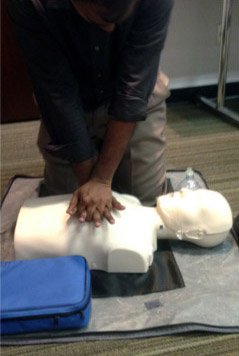
The latest: Push at least 100 times a minute, but not more than 120, and push at least 2 inches, but no more than 2.4.
(Photo credit: AHA)
CPR Timeline
(American Heart Association)
|

CPR Timeline
(American Heart Association)
Fast but not too fast, and deep but not too deep.
That’s the gently tweaked CPR compression guidance offered in the American Heart Association’s new 2015 guidelines for CPR and emergency cardiovascular care, just out in the Oct. 15 edition of Circulation. They’re minor changes, adding upper limits to existing parameters for rate and depth.
The new compression rate is 100–120 a minute; previously it was “at least 100.”
The new compression depth is 2–2.4 inches for adults and adolescents; it had been “at least 2 inches.”
Key data supporting the upper rate limit came from a 2015 study that found, with adjustments for compression fraction and depth, rates from 100–120 were associated with greatest survival to hospital discharge.1 At more than 120, rescuers appeared to tire and not push as hard, decreasing circulation. The compression rate for pediatrics now mirrors that of adults, though standard CPR is still recommended over compression-only CPR in children.
The depth limit was driven by a smaller study that suggested injuries could happen with compressions deeper than 2.4 inches.2 But don’t stop pushing hard, the chair of the AHA’s Emergency Cardiovascular Care Committee says; “Ribs bend with chest compressions,” Clifton Callaway, MD, noted in a summary of the new guidelines, “and the ‘injury’ is usually very mild. It definitely is not life-threatening.”
The new guidelines continue to promote hands-only CPR but also re-emphasize the value of breaths by those who can and will deliver them. Some additional key issues and major changes for BLS providers:
Similarly, the AHA notes evidence doesn’t show a benefit to the use of mechanical CPR devices, but they also “may be a reasonable alternative” where manual compressions are challenging or dangerous.
Some key issues and major changes for ALS providers:
For more on the new guidelines. emsworld.com
![]()
 |
 |
 |
 |
 To Kolb |
|---|